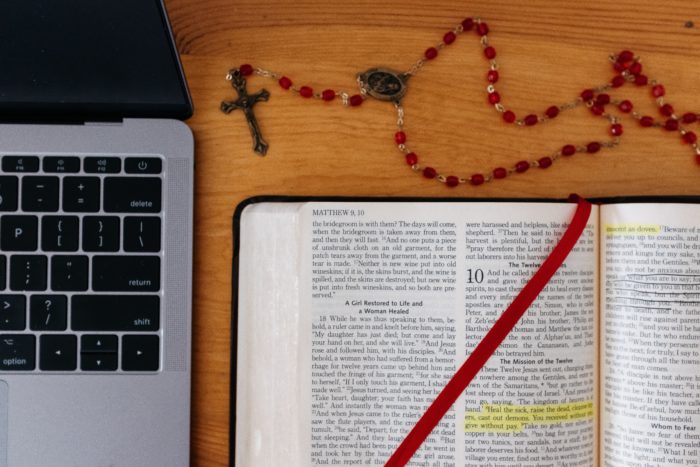Making “Sense” of Online Religion
In this post, Josiah Kidwell reflects on the ways COVID-19 has made the use of new technologies more central to religion, prompting a series of questions concerning religious practice, rituals and core norms.
On Good Friday, Catholics around the world followed a live broadcast of Pope Francis celebrating the Stations of the Cross in a deserted and rainy St. Peter’s Square. Those images, which highlighted the physical absence of the faithful, became one of the symbols of religion during COVID-19. There are countless other examples of religious communities finding new ways to connect in this difficult period. However, this crisis has profoundly transformed how people of faith access and practice their rituals. As in other social domains, religious groups are relying on new media technologies to address these challenges, though not always without controversy. Can virtual religious practices substitute for traditional, physical, social, and materially enacted sacred rituals? With this question mind, I will address several difficulties religious communities face in transitioning their services online, along with the role of the senses and materiality.
To begin, though, it is important to ask, how exactly are technology and spirituality connected? History provides us some interesting clues.

The first telegraphic message (image from Library of Congress)
With the invention of the telegraph, for example, people began to associate mystical and supernatural characteristics to this device that allowed them to transcend space and time. There are similar patterns with the advent of other technologies. Given these spiritual connotations, one might ponder the reinforcing effects of technology and spirituality, but it is important to remember how the sociohistorical context, along with religious traditions, practices, and authorities moderate this nexus. It is also unclear how dramatic decreases in face to face interactions may influence our perceptions of technological devices. Nevertheless, mandatory social distancing policies have created a moment for many groups, including religious ones, to reconsider and analyze the potentials and limitations that media technologies offer.
Mediating Religion: Conflicts and Consensus
In the context of this pandemic, the religious must cope with a public health emergency, while also negotiating the theological implications of mandatory social distancing and online religion. In this discussion, it is important to recognize the wide continuum of positions among religious traditions regarding the importance of social gatherings. Some eastern religious traditions, for example Buddhism, do not require frequent temple visits. Additionally, Arthur Versluis, professor of religious studies, suggests that, in the United States, “Buddhism tended to already be highly technologically savvy… so many groups or organizations transitioned swiftly to online meditation workshops and seminars.” However, other traditions, including, Christianity, Islam, and Judaism involve routine social rituals, services, and even international pilgrimages.
Among some groups, there have already been cases of conflicts between faith communities and political authorities enforcing social distancing. In Las Vegas, for example, local politicians along with religious leaders spoke out against state regulations preventing drive-thru services on Easter Sunday. Implicit in many of these arguments is the unresolved question of the substitutability of physical religious rituals with online alternatives. Many religious groups have been skeptical of technology, yet, in today’s circumstances, there seems to be a consensus that virtual religious “community” is better than none at all. The immediacy of this crisis has led religious organizations, many that had little or no media presence before, to transition to entirely online platforms.

Computer and Bible? (Image credit: Grant Whitty, Unsplash)
In my own research, I observed an online communion service at a prominent megachurch in Las Vegas. Although this church uses social media extensively, the practice of communion creates unique challenges. The pastor, standing behind a beautifully arranged table covered with bread, an ornamental wine bottle, wine glasses, grapes, and other decorative items, performed the virtual communion services. Just before the moment when, traditionally, servers would distribute the bread and wine to the congregation, the minister looked into the camera and instructed his audience to gather the needed items at home. If wine and bread were not available, he informed the homebound communicants that water and crackers would be acceptable. As these examples make clear, virtual communion is theoretically possible; however, its dogmatic legitimacy will have to be negotiated across different theological traditions. This, however, is easier for some groups than others.
Online religion may replace certain types of religious services; but, for strongly sacramental communities, Catholics, for example, there seem to be fundamentally physical practices that are necessary. Videoconferencing and virtual churches may effectively mediate face to face communication but not necessarily transubstantiation (the belief that the words of consecration transform the bread and wine into the actual body and blood of Christ). Even for less sacramental traditions in which physical rituals play smaller roles, dilemmas will likely arise about the necessity of physical, collective presence and how frequently it should occur. However, several major churches, including the Presbyterian Church (USA) have already confirmed that virtual communion is possible.
If the lack of shared material elements (bread, wine, texts, physical spaces, etc.) in online religion introduces challenges, the corresponding absence of physically present others also creates some difficulties. Infrequently discussed, though socially important practices such as the “kiss of peace,” times of fellowship, handshaking, etc. must undergo a significant transformation in an online environment. In addition, at least for certain Christian churches, leaders will have to consider whether or not the sacrament of confession has an essentially physical character. Some churches, indeed, have already begun offering drive-thru and phone confession to address COVID19 concerns, and as discussed above, drive-thru versions of worship services. Religious leaders, to my knowledge, have yet to precisely articulate the differences and relative benefits of online church vs. drive-thru services (in which members listen to live radio broadcasts together in the church parking). However, this example reveals the tacit knowledge that many congregations seem to share about the value of social proximity in religion experience.
Final Thoughts
As this discussion highlights, scholars have often considered religion in terms of dogmas, ideas, and abstractions, underemphasizing its unavoidably social, sensuous, and material character. However, as S. Brent Plate writes, to understand the depth of spirituality we need to be brought “to our religious senses, to become aware of the objects we have come to love across ages and continents and to realize how central they are to our spiritual lives.” Religious practice requires the “know-how” to shape material objects and bodies into tools that make present the sacred. In the history of religion, images become icons, vocal repetitions become chants, bones become relics, stones become sacred, and the Christian faithful around the world become the body of Christ. Today, however, the task religious “bodies” (organizational and biological) face is understanding how to enter sensuously into these physical/spiritual realities through new media technologies. Will it require religious communities to create novel, virtual rituals or only to represent the old rituals virtually? It is unclear how and if the complexities of spiritual life can be transmitted entirely through screen and keyboard. Nevertheless, conversations on this subject should emphasize the social, material, flesh and blood reality of religious experience, and how this may translate into the virtual world.
Josiah Kidwell is a Ph.D. Candidate and Instructor in the department of sociology at the University of Nevada-Las Vegas. His research analyzes religion and technology in contemporary society, focusing on megachurches in the United States.
Website: https://josiahkidwell.weebly.com
Twitter: @JosiahKidwell
